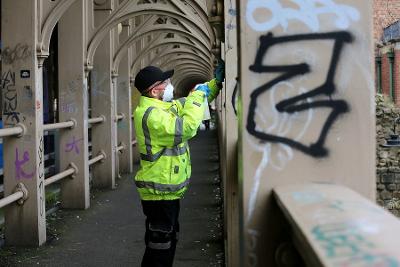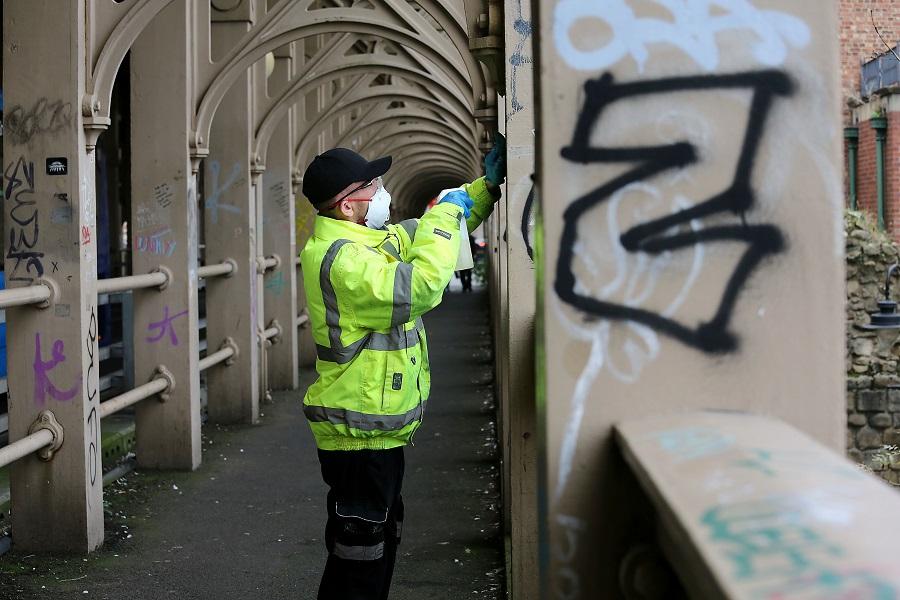High standards for the High Level Bridge

Work has been taking place to scrub away graffiti from across the structure of the historic High Level Bridge.
A team of staff from Gateshead Council have descended on the bridge, dating from 1849, with pressure washers and cleaning materials to attack the tags and other graffiti, and scrapers to clean off stickers.
The cleaning work has involved removing all graffiti on metalwork surrounding the road deck, foot and cycle paths, up to a height of around eight feet.
Cleaning of the stonework would require road closures and can't be undertaken at this time, but may form a separate phase of work on the 175 year old structure.
Network Rail is responsible for the overall structure of the High Level Bridge, and of course the rail deck, Newcastle City Council takes care of the road surface and lighting and Gateshead Council handles the paths.
Following the removal of graffiti, pigeon guano was removed, and the gullies and gutters cleaned.
We retained eight seasonal workers for an extra month to undertake the work required.
The High Level Bridge itself was opened by Queen Victoria on 28 September 1849. The public roadway over the bridge was not completed and opened until some six months later in early 1850.
The recent cleaning work on the Robert Stephenson-designed bridge has been paid for using UK Shared Prosperity Fund money, as the graffiti removal works will improve access over the bridge into the Railway Quarter.
The cleaning works have been completed in time for a festive market in the Railway Quarter planned for this Saturday (23 November).
The thriving pubs, bars and cafes in the area will be joined by a collection of street stalls featuring makers, food vendors and independent pop-ups.
It is an offence to damage or deface a listed structure and the council will take action against any individual found to have tagged or otherwise defaced the High Level Bridge.
The law authorises our neighbourhood wardens to issue fixed penalty notices to anyone caught doing graffiti. If you are prosecuted in court for graffiti, you could receive a substantial fine or even a prison term.
Councillor John McElroy, cabinet member for transport and the environment at Gateshead Council, said: "We are so lucky to have the High Level Bridge in our area. It's an iconic structure, and we want to appeal to everyone to value it, look after it - and report anyone you see causing damage to it.
"It's a real challenge to keep maintaining this listed, 175 year old bridge, but we want it to be here for another 175 years."
Report problems with the bridge or vandalism
The 408m (1338ft) long bridge was completely closed for maintenance in the early 2000s and when it re-opened, the road deck was only opened southbound (towards Gateshead) and now carries just buses and taxis. The one-way operation is required to manage the weight carried and because the width of the road is restricted by crash barriers on either side.

Work has been taking place to scrub away graffiti from across the structure of the historic High Level Bridge.
A team of staff from Gateshead Council have descended on the bridge, dating from 1849, with pressure washers and cleaning materials to attack the tags and other graffiti, and scrapers to clean off stickers.
The cleaning work has involved removing all graffiti on metalwork surrounding the road deck, foot and cycle paths, up to a height of around eight feet.
Cleaning of the stonework would require road closures and can't be undertaken at this time, but may form a separate phase of work on the 175 year old structure.
Network Rail is responsible for the overall structure of the High Level Bridge, and of course the rail deck, Newcastle City Council takes care of the road surface and lighting and Gateshead Council handles the paths.
Following the removal of graffiti, pigeon guano was removed, and the gullies and gutters cleaned.
We retained eight seasonal workers for an extra month to undertake the work required.
The High Level Bridge itself was opened by Queen Victoria on 28 September 1849. The public roadway over the bridge was not completed and opened until some six months later in early 1850.
The recent cleaning work on the Robert Stephenson-designed bridge has been paid for using UK Shared Prosperity Fund money, as the graffiti removal works will improve access over the bridge into the Railway Quarter.
The cleaning works have been completed in time for a festive market in the Railway Quarter planned for this Saturday (23 November).
The thriving pubs, bars and cafes in the area will be joined by a collection of street stalls featuring makers, food vendors and independent pop-ups.
It is an offence to damage or deface a listed structure and the council will take action against any individual found to have tagged or otherwise defaced the High Level Bridge.
The law authorises our neighbourhood wardens to issue fixed penalty notices to anyone caught doing graffiti. If you are prosecuted in court for graffiti, you could receive a substantial fine or even a prison term.
Councillor John McElroy, cabinet member for transport and the environment at Gateshead Council, said: "We are so lucky to have the High Level Bridge in our area. It's an iconic structure, and we want to appeal to everyone to value it, look after it - and report anyone you see causing damage to it.
"It's a real challenge to keep maintaining this listed, 175 year old bridge, but we want it to be here for another 175 years."
Report problems with the bridge or vandalism
The 408m (1338ft) long bridge was completely closed for maintenance in the early 2000s and when it re-opened, the road deck was only opened southbound (towards Gateshead) and now carries just buses and taxis. The one-way operation is required to manage the weight carried and because the width of the road is restricted by crash barriers on either side.
